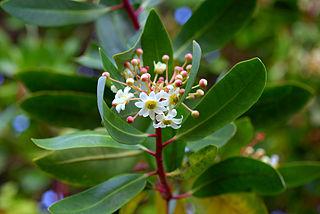
A tepui, or tepuy, is a table-top mountain or mesa found in South America, especially in Venezuela and western Guyana. The word tepui means "house of the gods" in the native tongue of the Pemon, the indigenous people who inhabit the Gran Sabana.

Drimys is a genus of about eight species of woody evergreen flowering plants, in the family Winteraceae. The species are native to the Neotropics, ranging from southern Mexico to the southern tip of South America. They are primitive dicots, associated with the humid temperate Antarctic flora of the Southern Hemisphere, which evolved millions of years ago on the ancient supercontinent of Gondwana. Members of the family generally have aromatic bark and leaves, and some are used to extract essential oils.

Canaima National Park is a 30,000 km2 (12,000 sq mi) park in south-eastern Venezuela that roughly occupies the same area as the Gran Sabana region. It is located in Bolívar State, reaching the borders with Brazil and Guyana. The park was named a World Heritage Site by UNESCO.
La Gran Sabana is a region in southeastern Venezuela, part of the Guianan savanna ecoregion.

The tepui tinamou is a type of ground bird found in montane moist forest on tepuis, in southeastern Venezuela.

The tepui goldenthroat is a species of hummingbird in the subfamily Polytminae, the mangoes. It is found in Brazil, Guyana, and Venezuela.
Pristimantis marahuaka is a species of frog in the family Strabomantidae. It is endemic to the summit of Cerro Marahuaca, a tepui in central Amazonas state, Venezuela. Its natural habitat is tepui shrubland at around 2,450 m (8,040 ft) asl where it is common in the mossy bases of Heliamphora plants.
Pristimantis pruinatus is a species of frog in the family Strabomantidae. It is endemic to Venezuela and only known from its type locality, the summit of Cerro Yaví, a sandstone table-top mountain (tepui) in the Amazonas State. The specific name pruinatus refers to the frosted appearance of this frog when alive and is derived from the Latin pruina (="frost") and -atus.
Pristimantis yaviensis is a species of frog in the family Strabomantidae. It is endemic to Venezuela and known from its type locality, the summit of Cerro Yaví, a sandstone table-top mountain (tepui), and from Cerro Yutajé, both in the Amazonas State. The specific name yaviensis refers to the type locality.

The tepui swift is a species of bird in subfamily Cypseloidinae of the swift family Apodidae. It is found in Brazil, Guyana, and Venezuela.

The tepui wren is a species of bird in the family Troglodytidae. It is found in Brazil, Guyana, and Venezuela, where it inhabits high tablelands called tepuis.
Cerro Marahuaca, also spelled Marahuaka, is a tepui in Amazonas state, Venezuela. It has an elevation of 2,832 metres (9,291 ft) above sea level and is the second-highest mountain of the entire Guayana Shield. Cerro Marahuaca shares a common base with the much larger Cerro Duida and together they form the Duida–Marahuaca Massif. Both tepuis are located entirely within the bounds of Duida–Marahuaca National Park.
Upuigma-tepui, also known as El Castillo, is a tepui in Bolívar state, Venezuela. A relatively isolated peak, both it and nearby Angasima-tepui lie just south of the vast Chimantá Massif, from which they are separated by the Río Aparurén valley. Upuigma-tepui is situated entirely within the bounds of Canaima National Park.

The tepui toucanet or Whitely's toucanet is a near-passerine bird in the toucan family Ramphastidae. It is found in Brazil, Guyana, Suriname, and Venezuela.
Los Testigos, also known as the Aparamán range, is a mountain chain in Bolívar, Venezuela. It consists of four rather small tepuis, forming a bridge between the giant Auyán-tepui to the west and Ptari-tepui to the east. The four major peaks of Los Testigos are : Aparamán-tepui (2,100 m), Murisipán-tepui (2,350 m), Tereke-yurén-tepui (1,900 m), and Kamarkawarai-tepui (2,400 m), the latter three sharing a common slope area. There however remains some confusion in the literature regarding the names of these peaks.
Angasima-tepui, also known as Adanta, Adankasima or Adankachimö, is a tepui in Bolívar state, Venezuela. A relatively isolated peak, both it and nearby Upuigma-tepui lie just south of the vast Chimantá Massif, from which they are separated by the Río Aparurén valley. Amurí-tepui, the closest member of the Chimantá Massif, is only 8 kilometres (5.0 mi) from Angasima-tepui.
Cerro Aracamuni is a granitic tepui in Amazonas state, Venezuela. Part of the Neblina–Aracamuni Massif, it lies north of Cerro Avispa and the vast complex of Cerro de la Neblina. Cerro Aracamuni and Cerro Avispa share a common slope area; they have a combined summit area of 238 km2 (92 sq mi) and an estimated combined slope area of 658 km2 (254 sq mi). Both of these cerro-plateaus have a maximum elevation of around 1,600 metres (5,200 ft).
Jaua-Sarisariñama National Park was located in the Guayana Highlands, within Bolívar State of southeastern Venezuela. It was established in 1978. It has been subsumed within Caura National Park, which was established in 2017.
Drimys brasiliensis is a broadleaf evergreen tree of family Winteraceae. it is native to Atlantic Forest of eastern Brazil, western Paraguay, and northwestern Argentina, and to Bolivia.

Drimys confertifolia is a species of flowering plant in family Winteraceae. It is native to Juan Fernández Islands off the western coast of South America.








